2025 Marijuana Industry Statistics & Data Insights
How the industry is performing and where it's headed

For the cannabis industry, the only constant is change. Marijuana regulations, laws, sentiment, technology and business practices evolve each year—meaning there’s a long list of new data and insights to unpack.
To paint a clear picture of the cannabis industry, we scoured the internet to find the most important and relevant marijuana statistics for 2025.
In this report, you’ll see marijuana use statistics, the national sentiment around weed acceptance/accessibility, marijuana market growth, employment trends, and legal facts.
Let’s dive into the findings.
Key findings:
47% of Americans have tried cannabis.
79% of Americans live in a county with at least one dispensary.
There are 440,445 full-time equivalent jobs supported by legal cannabis.
The US cannabis industry is expected to reach almost $45 billion in 2025.
More than 1 in 3 women over 21 consume cannabis.
Cannabis added approximately $115.2 billion to the economy in 2024.
Adult-use cannabis is now legal in 24 states.
Support for legalizing cannabis hit a record 88%.
Ranks of women and minority cannabis executives are rebounding.
14% of consumers use cannabis to help them exercise.
Cannabis tax revenue is $20 billion, nearly double that of alcohol.
Average retail cannabis prices have dropped -32% since 2021.
Dispensaries accepting debit earns an average of $4,627 more than cash-only retailers.
Marijuana usage statistics
15% of Americans identified as “current users”
The most recent data from Gallup (combined from 2023 and 2024) , shows that 15% of Americans are active marijuana users, which is up slightly (from 14% in 2021-2022).
In 2021, the number of people who use marijuana began slightly increasing, and we see that trend continuing in 2025.
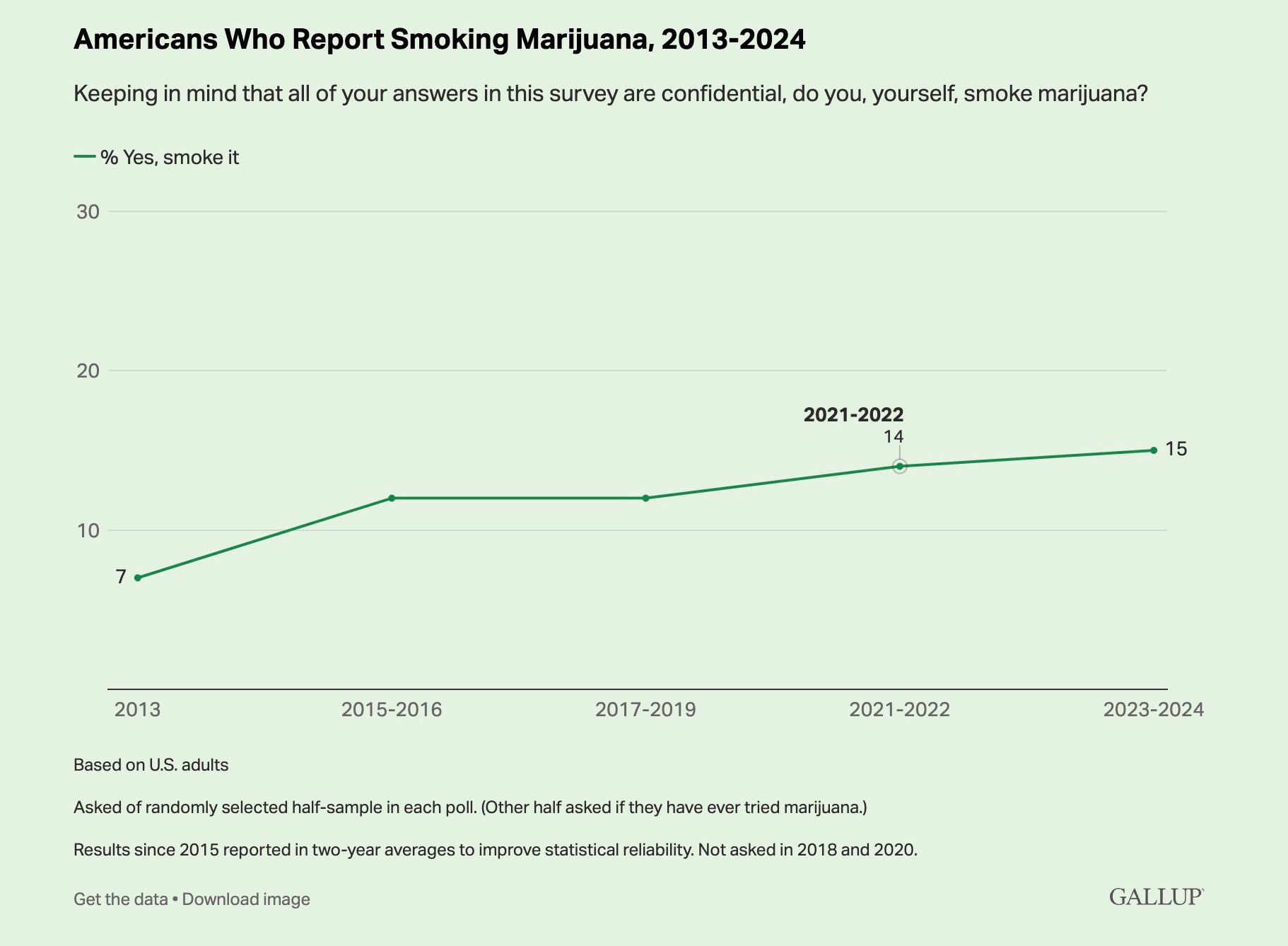
Marijuana usage statistics
Nearly half of Americans have tried cannabis
According to Gallup, 47% of Americans say they have tried marijuana at some time.
64% of consumers use cannabis to relax
52% use cannabis to reduce anxiety
48% of consumers turn to cannabis for pain management
45% use cannabis to improve sleep quality
45% say cannabis helps them fall asleep
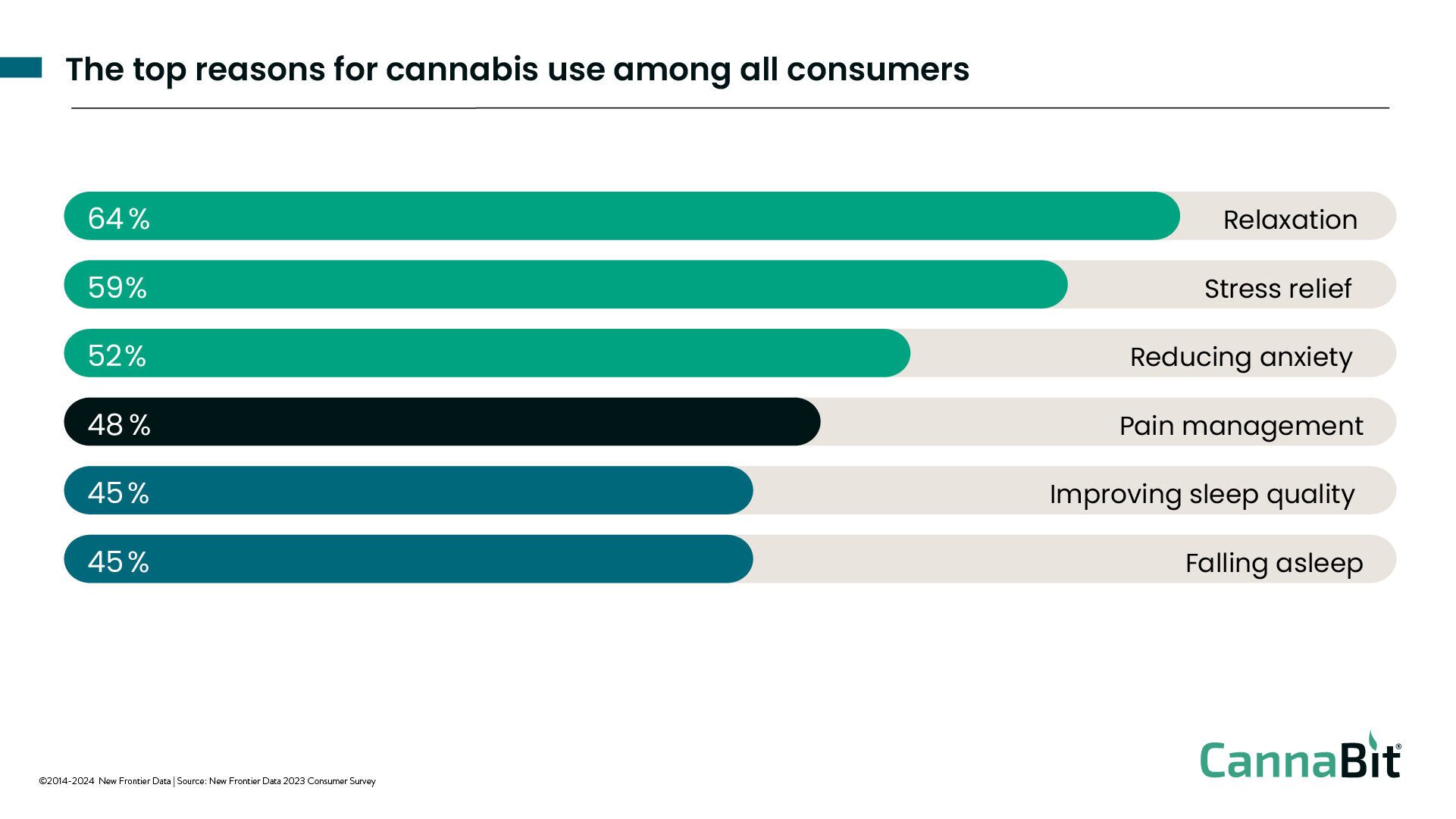
Pre-rolls were the fastest-growing product category in 2024
Pre-roll sales jumped 11.89% from June 2023 to June 2024, making it the product category with the biggest increase in sales revenue during that period.
More than $4.1 billion in pre-roll sales were completed, and over 394 million units were sold.
Infused pre-rolled joints saw the most growth within the pre-roll category, maintaining an average 43.4% market share in the product segment.
Cannabis beverage growth is closing in on pre-rolls
Cannabis beverages grew 11% during the year ending June 2024, according to a study from Headset.
BDSA found that the U.S. beverage category represented $54 million in total sales from Q2 2023 to Q2 2024.
The top 10 best-selling THC beverage brands represented 59% of all total cannabis drink sales, leaving 41% of the market split between the remaining brands.
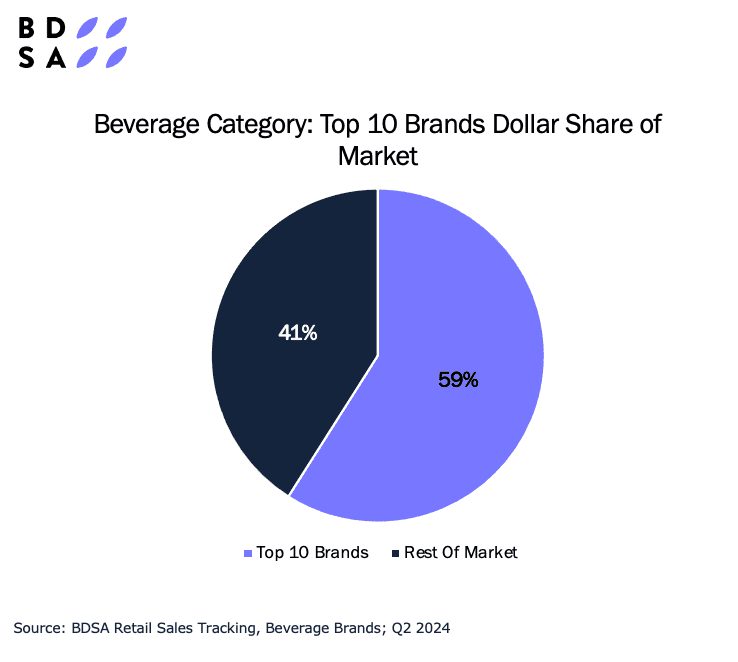
21% of cannabis consumers use flower
Statista found that 21% of American people between the ages 18-64 prefer flower when they consume. (Here are the best-selling cannabis strains of 2024 according to Leafly if you’re curious!)
16% prefer edibles
15% favor cartridges and vapes
13% go for pre-rolls
6% like extracts
4% choose a topical
40% of those surveyed like these products in CBD form
52% reported not consuming cannabis products at all
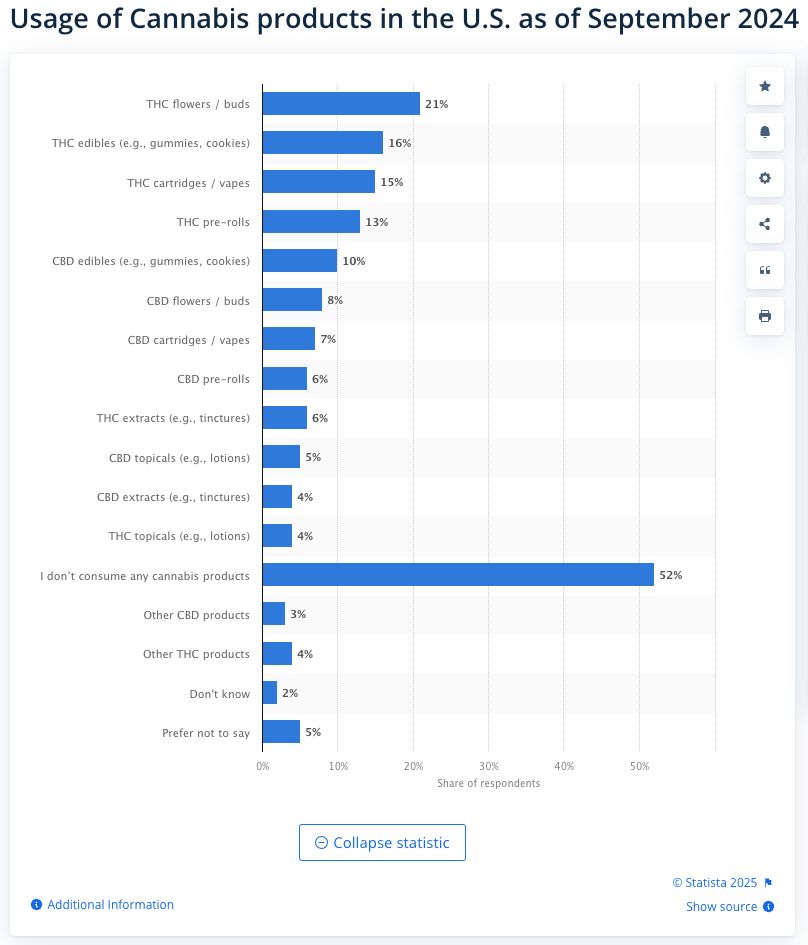
More than 1 in 3 American women consume cannabis
Data shows that more than 1 in 3 women consume cannabis in the U.S., which means there are more female cannabis consumers than male.
Cannabis brands are beginning to notice this trend and are investing more heavily in this demographic.
Retailers say they are refocusing shelf space toward products women tend to purchase, like topicals, edibles, tinctures, and beverages.
The U.S. National Institute on Drug Abuse found that, for the first time, women surpassed men of the same age in cannabis consumption in 2023.
Reuters reported that women also comprise 55% of the user base on Jointly, a consumer-focused cannabis product discovery app with over half a million users.
Men and women consume cannabis differently and for different reasons
29% of female consumers prefer non-flower products, while 15% of men prefer the same.
27% of men prefer to consume flower
Just 19% of women say flower is their preference
59% of men and 52% of women prefer flower and non-flower
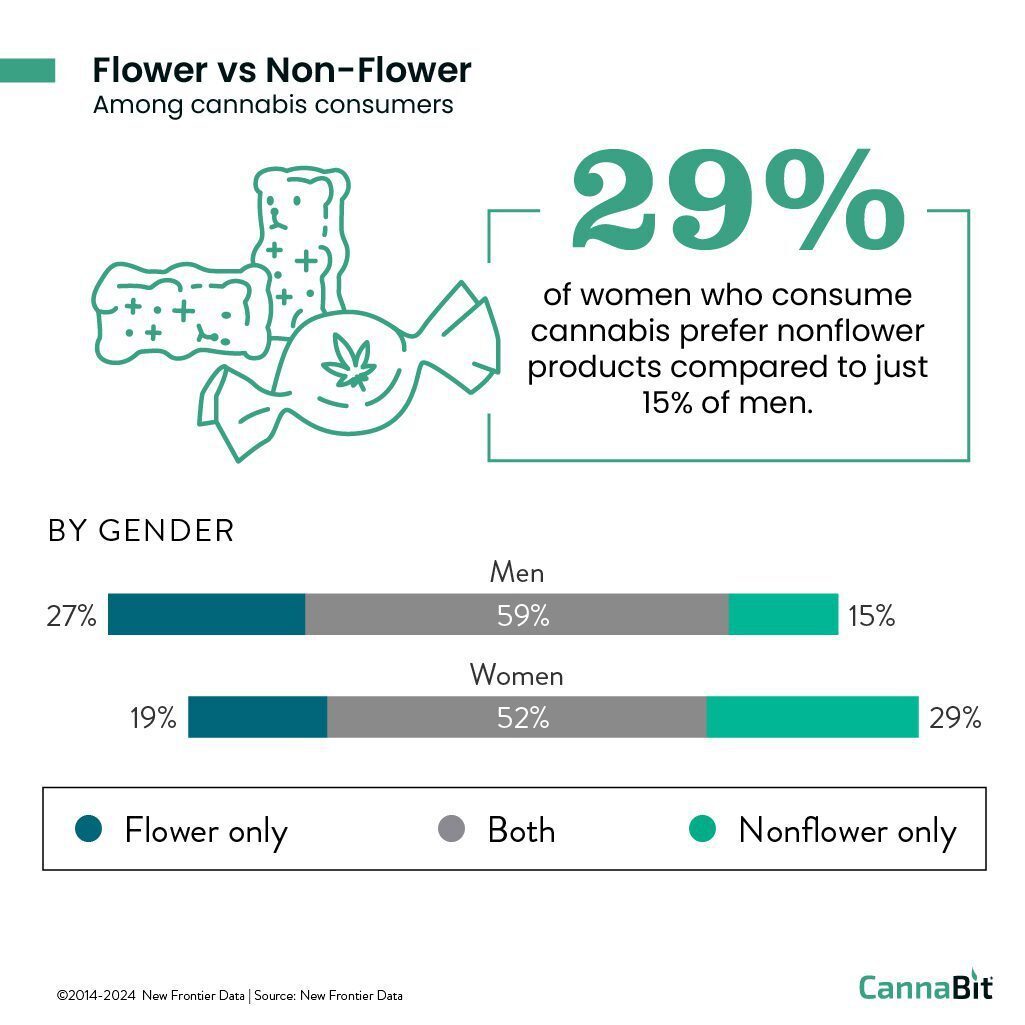
14% of consumers use cannabis to help them exercise
Cannabis consumers are continuing to crush the lazy stoner stereotype. Data shows that 14% of cannabis consumers use cannabis for exercise.
47% of those who consume for exercise say it helps their motivation before a workout
56% use it for greater relaxation and enjoyment during the workout
48% consume to focus better during their workout
31% use cannabis for increased endurance
47% say cannabis helps them recover after a workout
33% report cannabis supports a faster recovery
Cannabis consumption declined among 12th graders in 2024
In 2024, cannabis consumption declined among 12th graders, with 25.8% reporting cannabis use in the past 12 months. In 2023, 29% of 12th graders said they consumed cannabis in the past year.
Cannabis consumption remained stable among eighth and tenth graders who self-reported use, totaling 7.2% and 15.9%, respectively.
Psychiatric patients who are prescribed cannabis are less likely to have suicidal thoughts
A 2024 study found that three months after beginning cannabis treatment, “there was a reduction in both the percentage of the sample reporting suicidal ideation and the mean severity of suicidal ideation.
Twelve-month follow-up indicated a substantial reduction in depressed mood with this reduction being more pronounced in those reporting SI [suicidal ideation at baseline.]"
79% of Americans live in a county with at least one dispensary
Most Americans now live in a state that has legalized cannabis. Pew Research broke down the details to find:
- 54% of Americans live in a state where the recreational use of marijuana is legal.
- 74% of Americans live in a state where cannabis is legal for either recreational or medical use.
- 79% of Americans live in a county with at least one cannabis dispensary.
- There are nearly 15,000 cannabis dispensaries in the United States.
- California has far more dispensaries than any state: 3,659 at the time of this analysis, more than double the amount in the second-highest ranking state. A quarter of all marijuana dispensaries in the U.S. are in California, and nearly all Californians (99.5%) have a dispensary in their county. Los Angeles County alone has more dispensaries (1,481) than any state other than California itself.
- Oklahoma has the most marijuana dispensaries per capita of any state: 36 dispensaries for every 100,000 residents.
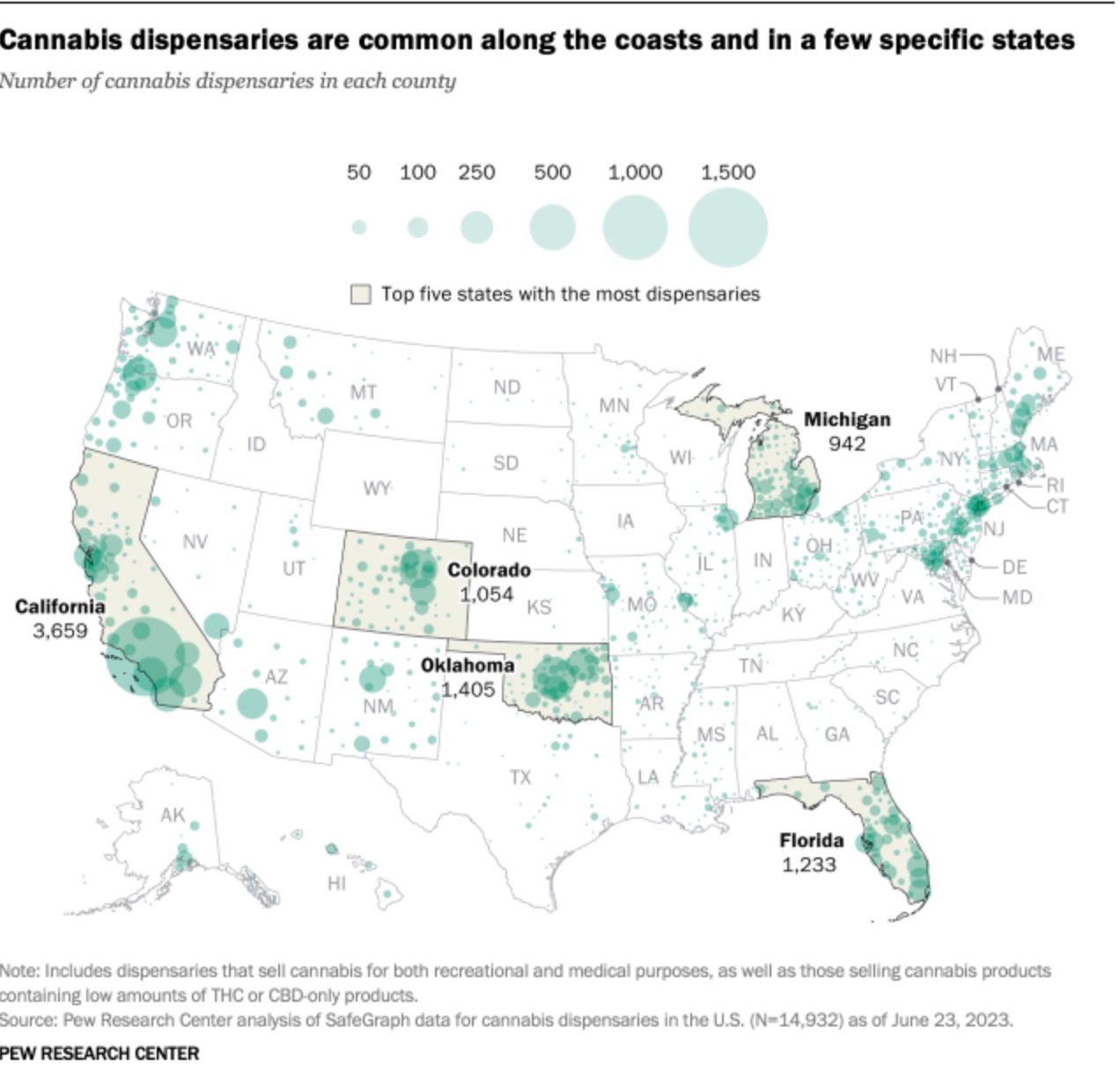
21% of Dry January participants are replacing alcohol with cannabis and CBD
A survey from CivicScience found that 21% of people doing Dry January — a popular trend where you abstain from alcohol for the month — are replacing alcohol with cannabis and CBD.
The same survey uncovered that the largest demographic of people replacing alcohol with cannabis are aged 21-24 (34%), followed by 25-34-year-olds (24%).
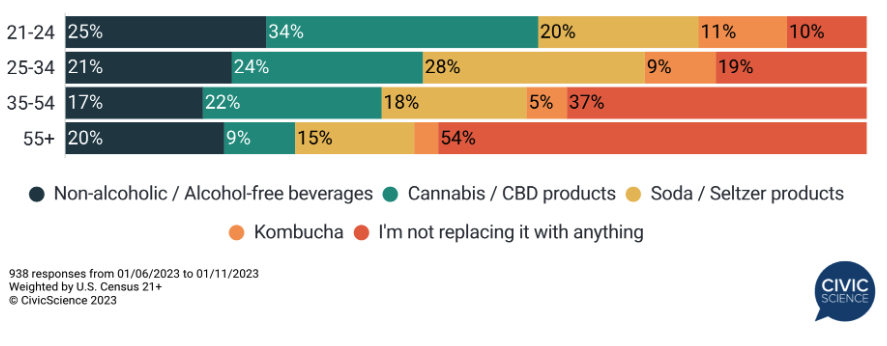
We’ve seen this trend of younger individuals replacing alcohol with cannabis rising since the pandemic. These Dry January statistics confirm the assumption that more people from younger generations are turning away from alcohol and using cannabis as an alternative.
Read Next:
See how STIIIZY is scaling with Flowhub
STIIIZY was the top concentrate brand of 2024
New Frontier Data found that California’s largest cannabis retailer, STIIIZY, was the top-selling concentrate brand in 2024 based on the number of transactions.
WYLD was the top-selling brand of edibles
RYTHM was the #1 flower brand
Dogwalkers were the top-selling pre-roll
&Shine was the #1 selling vape
Younger consumers prefer cannabis vape pens
Together, Gen Z and Millennials make up 62.8% of all US cannabis sales and 70.8% of all Vapor Pen sales based on data from Headset.

Gen Z is already known to be attracted to nicotine vaporizers, which influences the way they consume cannabis. This is likely due to their familiarity with the consumption method since we see diminishing Vapor Pen preference with increasing age.
14% of Americans use CBD products
CBD is a broad category, and has hit mainstream since becoming federally legal in 2018. While marijuana users and CBD users may be different, it’s important to note usage in this group.
According to Gallup, 14% of all U.S. adults use CBD. This jumps to 20% for those ages 18-29.
Perhaps most interesting is the question of familiarity with CBD products: 49% of those age 65+ are unfamiliar with CBD (compared to just 26% of those age 18-29).
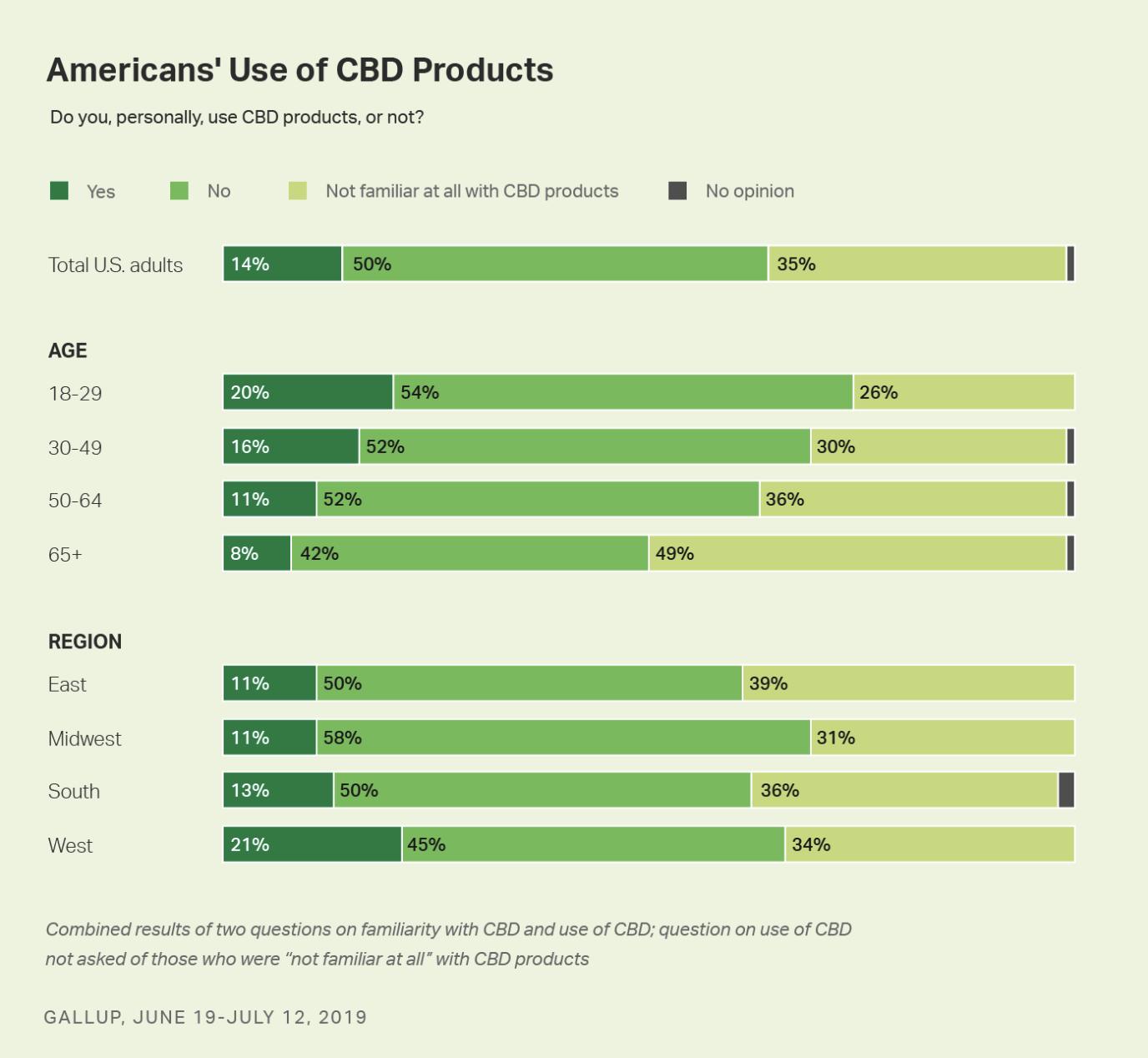
The same study found the most common reasons for using CBD include:
Pain - 40%
Anxiety - 20%
Sleep/Insomnia - 11%
Arthritis - 8%
Migraines/Headaches - 5%
SingleCare, a medical prescription savings company, ran a similar survey in April of 2020 and found that 45% of current CBD users increased their use of CBD once the pandemic began.
Interestingly, their 2020 study found that 49% of CBD users take CBD to help with stress and anxiety, which is nearly 30% more than the 2019 Gallup poll.
Acceptance of marijuana in the US
39% of consumers say they give cannabis to friends and family
Cannabis acceptance is on the rise, and nothing proves it more than 39% of consumers saying they give cannabis products to friends and family.
93% of cannabis consumers say their friends know they consume
89% of cannabis consumers say their family knows they consume
59% of consumers say friends and family are generally supportive of their consumption
26% of cannabis consumers say cannabis is sometimes part of holiday gatherings with family
Marijuana for recreational use is legal in 24 U.S. states
As of January 2024, 24 states, the District of Columbia, and Guam have legalized recreational cannabis use for individuals age 21+: Alaska, Arizona, California, Colorado, Connecticut, Delaware, Illinois, Maine, Maryland, Massachusetts, Michigan, Minnesota, Missouri, Montana, Nevada, New Jersey, New Mexico, New York, Ohio, Oregon, Rhode Island, Vermont, Virginia, and Washington.
Delaware, Minnesota, and Ohio were added to the list of legal adult-use cannabis states in 2023.
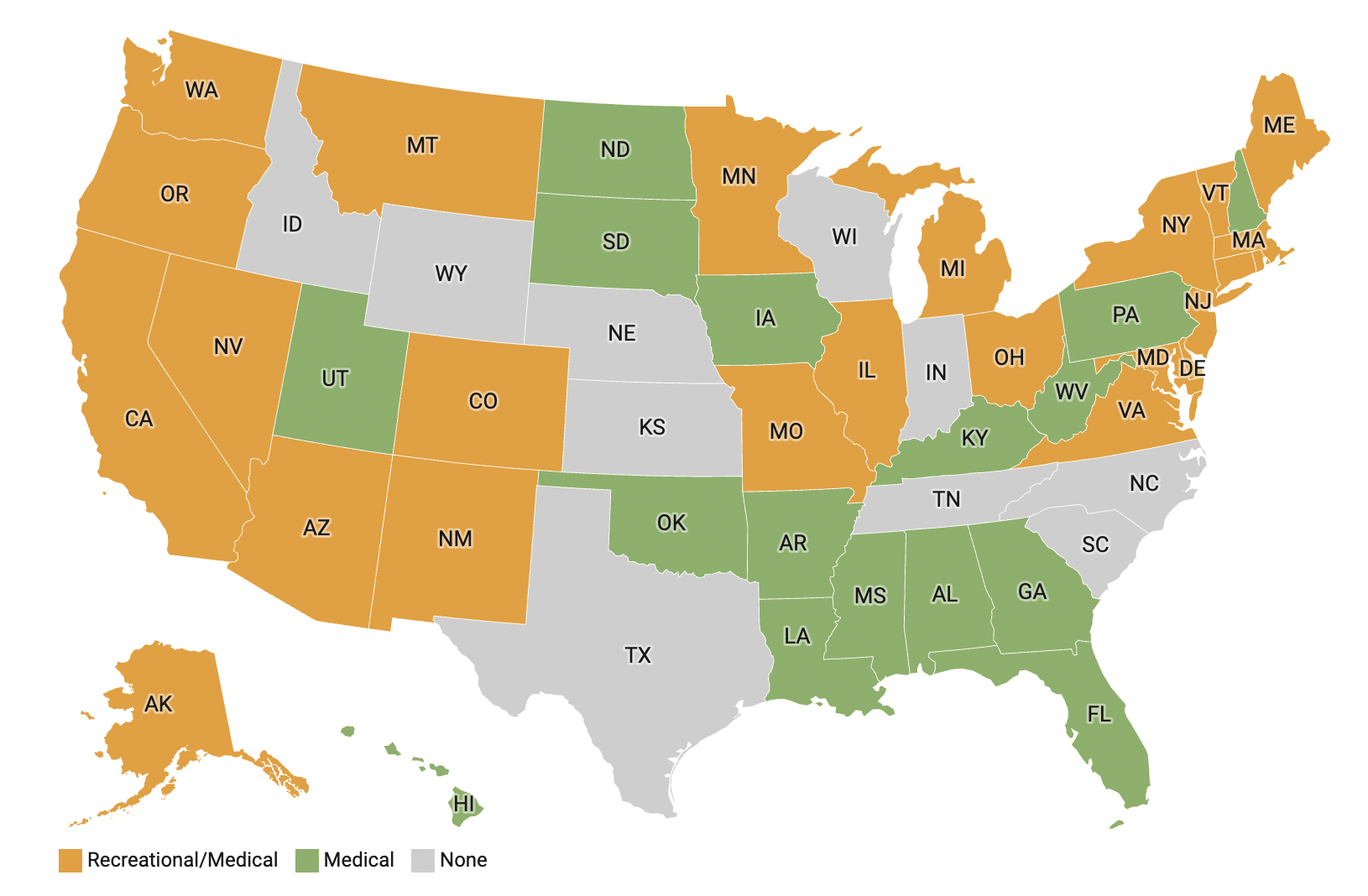
Medical marijuana is now legal in 41 US states
Medical use of marijuana is now legal in 41 states plus Washington D.C. for medical purposes: Alabama, Alaska, Arizona, Arkansas, California, Colorado, Connecticut, Delaware, Florida, Hawaii, Illinois, Kansas, Kentucky, Louisiana, Maine, Maryland, Massachusetts, Michigan, Minnesota, Mississippi, Missouri, Montana, Nevada, New Hampshire, New Jersey, New Mexico, New York, North Dakota, Ohio, Oklahoma, Oregon, Pennsylvania, Rhode Island, South Carolina, South Dakota, Utah, Vermont, Virginia, Washington, and West Virginia.
Nebraska was added to the list of legal medical cannabis states in 2024.
Support for legalizing cannabis is at a record 88%
According to recent data from Pew Research, nearly 9 in 10 Americans think cannabis should be legal for medical or recreational purposes, the highest level ever recorded.
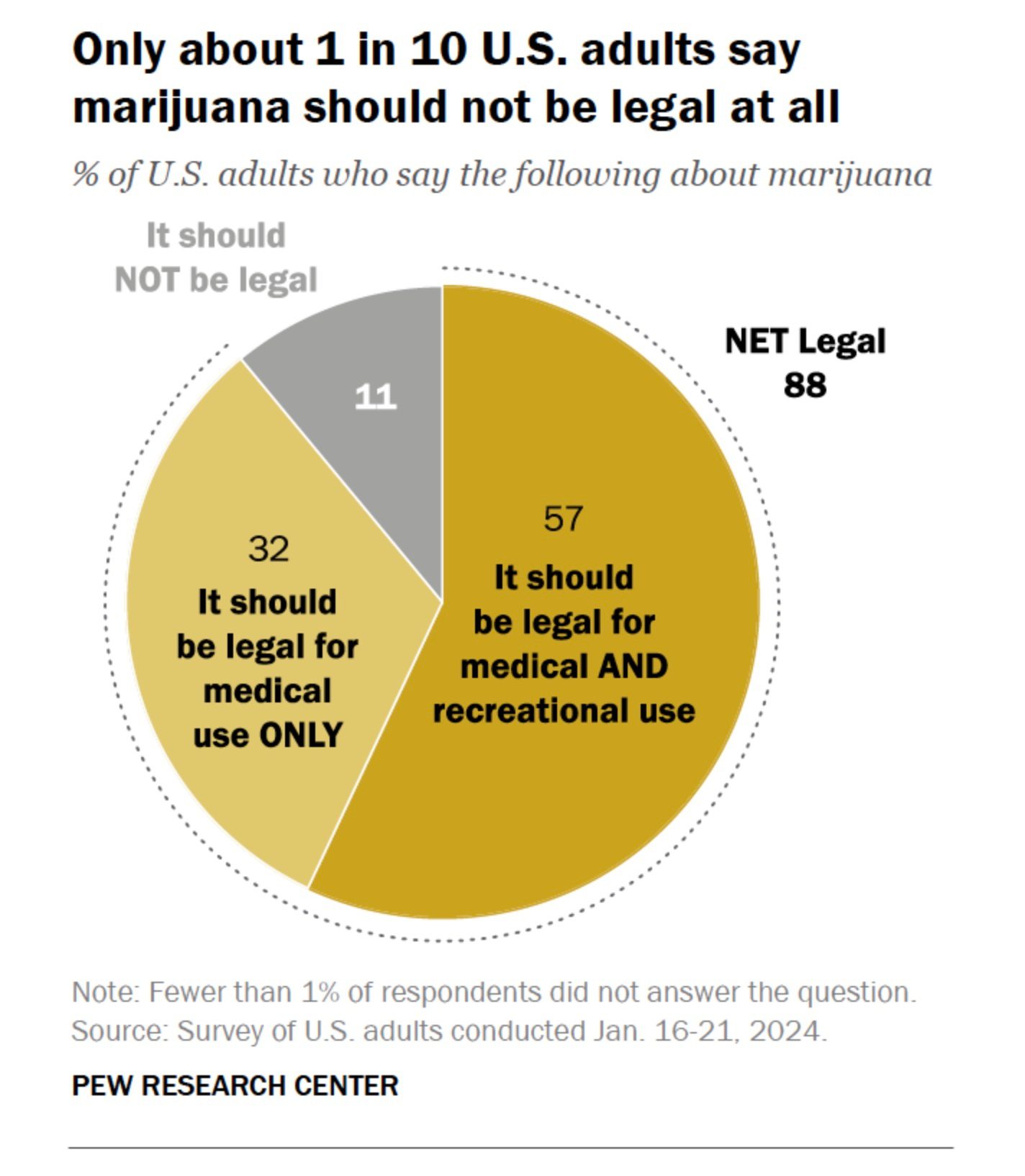
Just 11% of Americans believe cannabis should not be legal at all
52% of U.S. residents say legalizing cannabis is good for local economies
17% of Americans believe cannabis is bad for local economies
29% feel that cannabis has no impact on the economy
How Americans view the effects of legal cannabis
About half of Americans (52%) say that legalizing the recreational use of marijuana is good for local economies; just 17% think it is bad and 29% say it has no impact
More adults also say legalizing marijuana for recreational use makes the criminal justice system more fair (42%) than less fair (18%); 38% say it has no impact.
Americans have mixed views on the impact of legalization on other drug use and community safety.
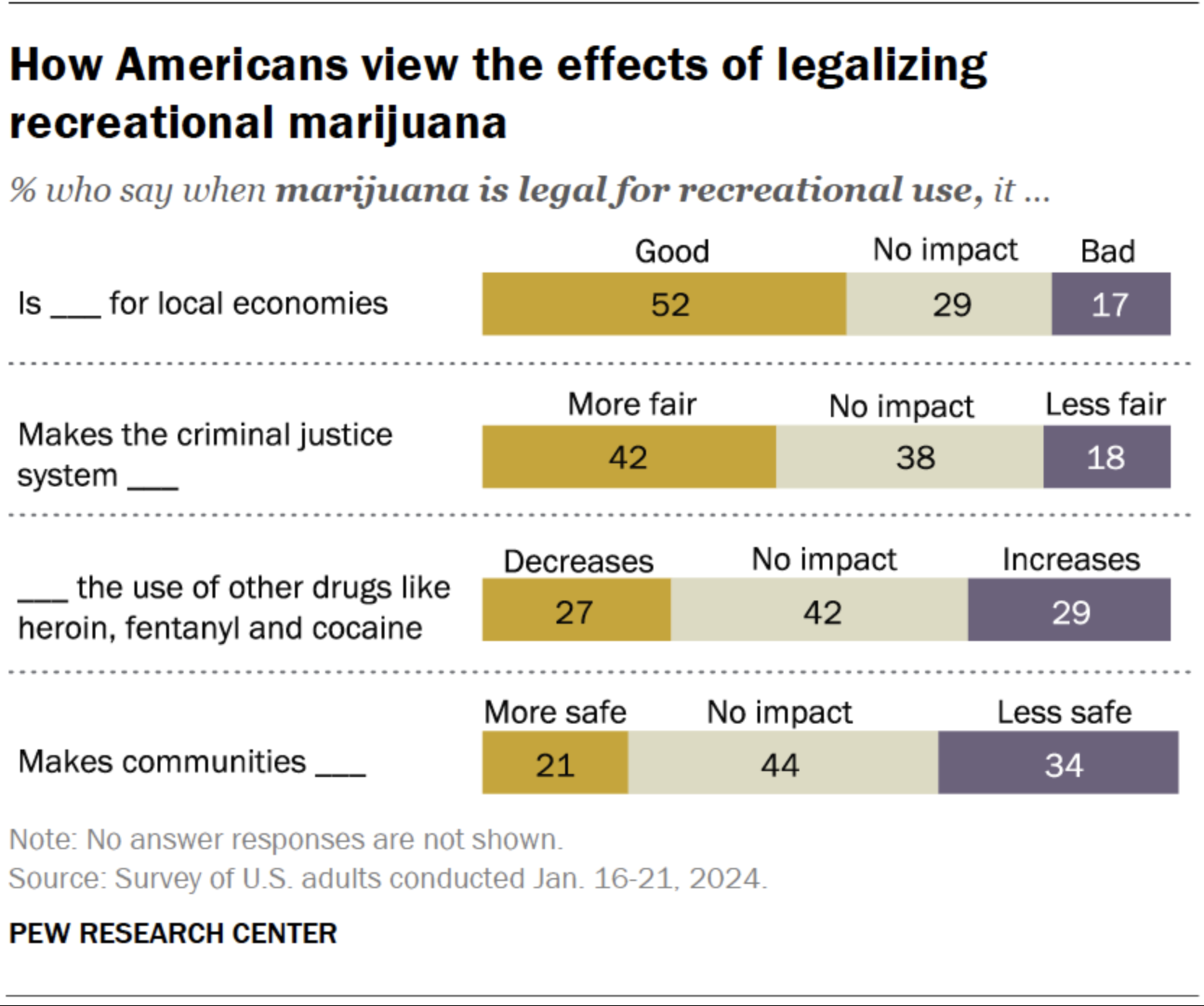
Medical cannabis improves quality of life for veterans
A recent study published in Clinical Therapeutics found 91% of military veterans who visit providers for medical cannabis said it has improved their quality of life.
Medicinal cannabis use was reported to improve quality of life and reduce unwanted medication use by many of the study participants. The present findings indicate that medicinal cannabis can potentially play a harm-reduction role, helping veterans to use fewer pharmaceutical medications and other substances.
Clinical Therapeutics, June 2023
As marijuana use is more broadly accepted, its prevalence for positive health effects and benefits toward public health are increasing. For veterans struggling with PTSD, substance use, illicit drug use, and more, the cannabis plant has entered as a supplement for traditional health care and prescription drugs.
Cannabis market opportunity
The US cannabis industry is expected to reach almost $45 billion in revenue in 2025
According to projections from Statista, total revenue from cannabis is expected to reach $45.3 billion in 2025.
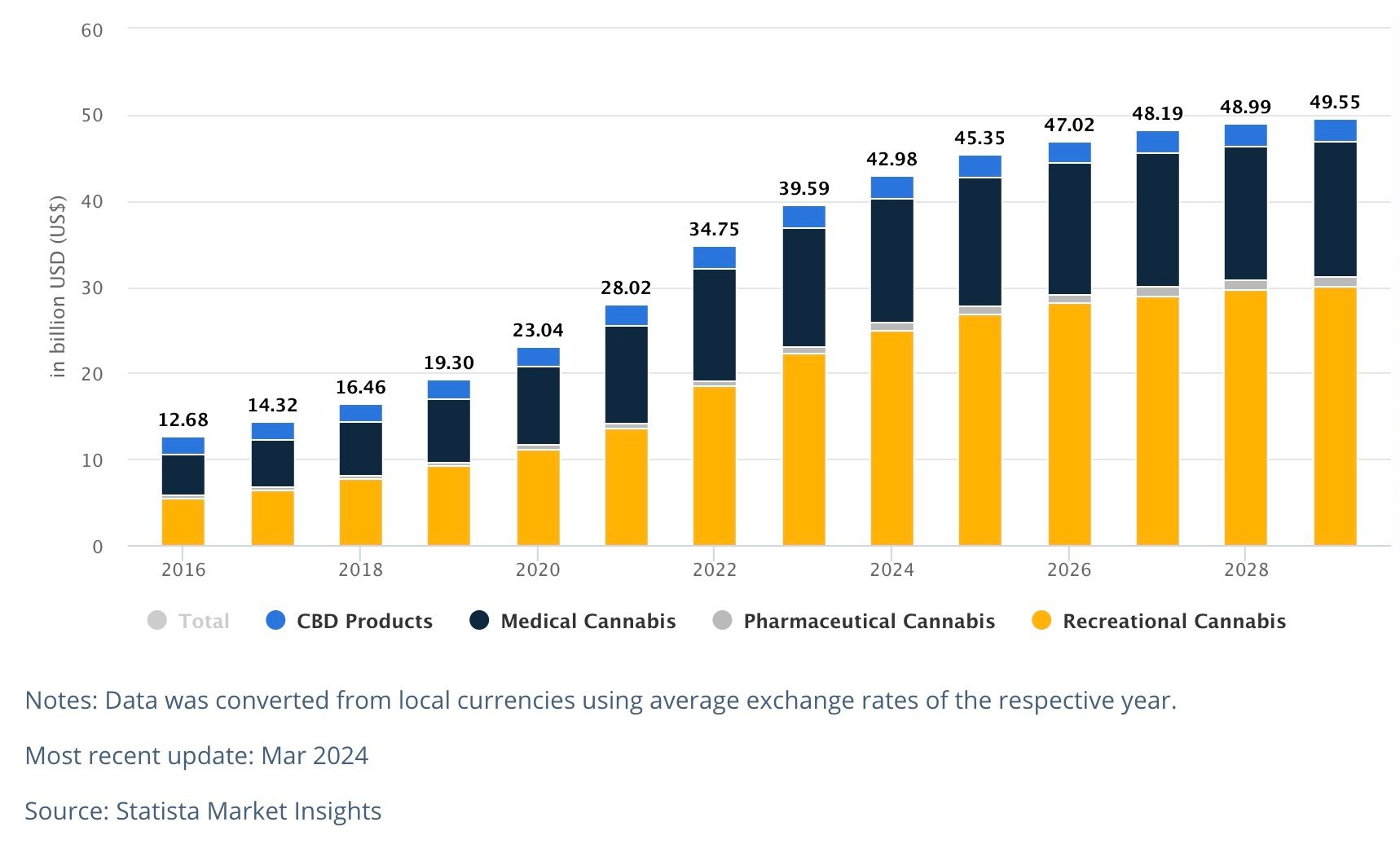
Statista projects the cannabis market volume to reach over $49.56 billion by 2028 as the legalization movement surrounding cannabis evolves.
Cannabis sales grew $2.6 billion in 2024
According to Whitney Economics, U.S. adult-use and medical cannabis sales grew $2.6 billion (9.14%) year-over-year, totaling $31.4 billion in 2024.
Whitney Economics predicts cannabis to see extreme sales growth over the next few years:
2025: $35.2 billion in sales, growing 12.1% from 2024
2030: $67.2 billion in cannabis sales
2035: $87.0 billion in cannabis sales
Cannabis prices are still compressing, and brands are consolidating
Competitive pricing trends among cannabis brands and retailers have led to significant price declines beginning in 2021.
While there are signs this compression is slowing and even rising in some states, it’s important to track this compression.
BDSA Retail Sales Tracking found equivalent average retail prices (EQ ARP) dropped -32% (from their peak in Q3 2021 to Q2 2023).
This price decline, along with inflation (which has increased costs for labor and materials for licensees), has made the industry even more competitive.
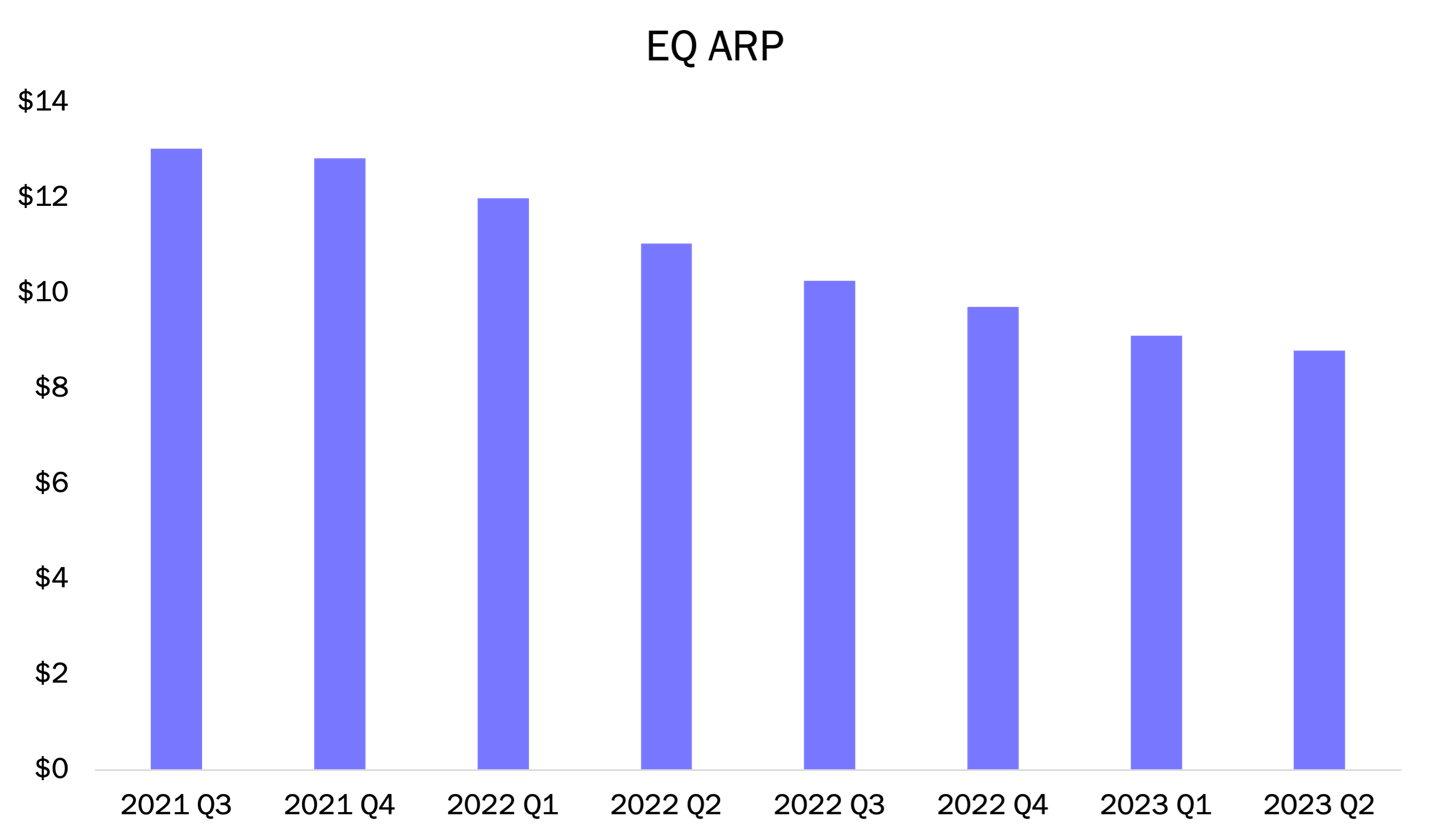
Compressing prices impact cannabis brands and retailers, squeezing profit margins and forcing dispensaries to fight to combat the effects of marijuana price compression.
For THC brands, price compression has led to considerable consolidation. Across all BDSA-tracked markets, the share of total sales held by the five best-selling brand houses grew by +14% between Q2 2021 and Q2 2023.
Similarly, around 25% of the 50 best-selling flower strains in both California and Colorado come from a single brand. This shows just how competitive (and compressed) the brand landscape is becoming.
Cannabis adds approximately $115.2 billion to the economy in 2024
According to the MJBizFactbook, for every $10 consumers and patients spend at dispensaries, an additional $18 will be injected into the economy.
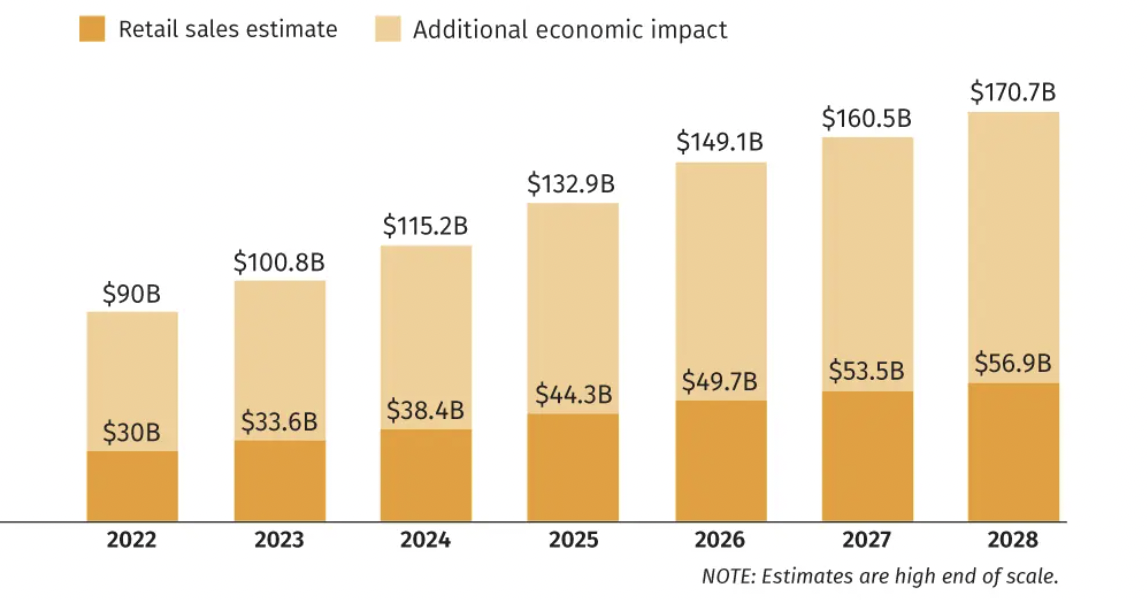
Much of this economic stimulation happens at the local level, contributing to growth in the same neighborhoods where the cannabis products are being sold.
Missouri cannabis market crosses $3B
Missouri recreational cannabis sales started on February 3rd, 2023. Since then, Missouri has seen $3.2 billion in adult-use cannabis sales.
Men make up 64% of cannabis sales in Missouri
More than 40% of dispensary shoppers in Missouri are millennials
Nearly 50% of sales in Missouri consist of flower
This rate of growth in Missouri outpaces markets like Arizona, Colorado, and Nevada.
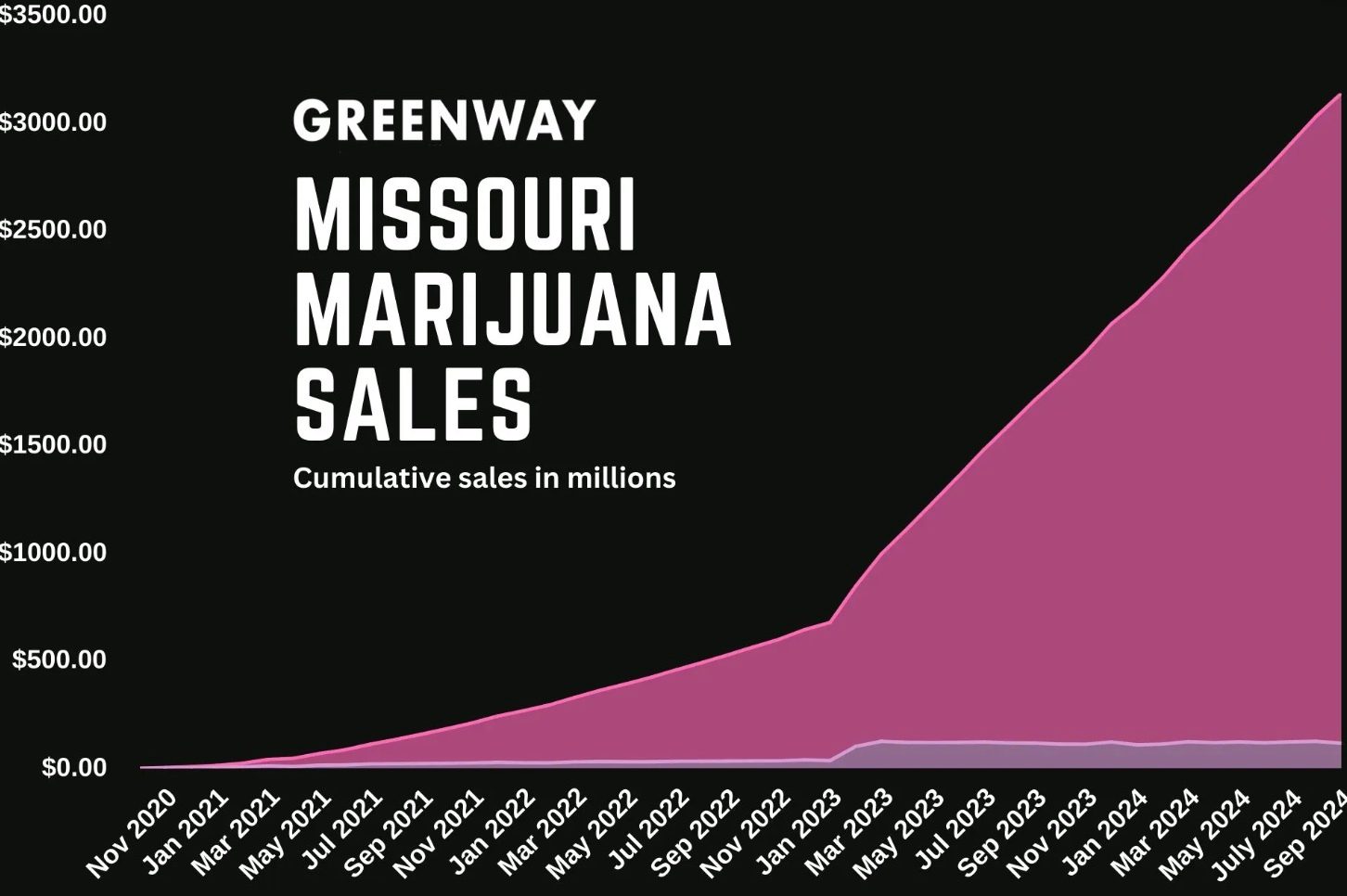
Over $20 billion in tax revenue was reported in 2024, nearly double that of alcohol
Cannabis is often compared to the alcohol industry, even though the two are innately different.
It appears cannabis isn’t just better for avoiding hangovers, it’s also earning states more money in tax revenue.
In 2024, more than $20 billion in cannabis tax revenue was generated. Statista reported that the alcohol industry generated $9.6 billion in 2024.
Cannabis market trends
Cashless payments improve dispensary performance
Flowhub data from Green Wednesday 2023 found dispensaries accepting debit cards earned an average of $4,627 more per day than cash only retailers.
Additionally, dispensaries offering debit payments processed 59% more transactions compared to cash only dispensaries and transactions paid with a debit card were $13 higher than cash only transactions.
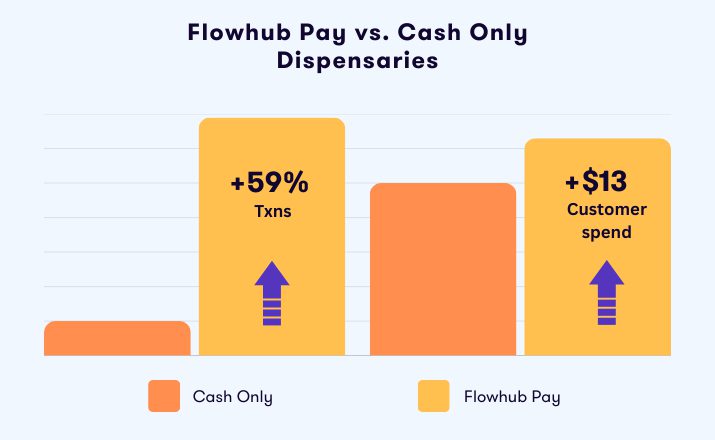
Despite its history of being a cash-based industry, cannabis consumers still want to pay with cards.
We're seeing this trend accelerate in all other industries too. In 2024, cash payments represented just 16% of all transactions.
Expect to see continued adoption and growth of cannabis debit payments throughout 2024.
Looking for a cannabis payments provider? See if you qualify for Flowhub Pay.
Millennials capture nearly half of every dollar spent on Cannabis in the US
Headset’s Demographics Report notes the millennial age group is the largest demographic of cannabis consumers, capturing 46.2% of every dollar spent on weed.
However, Gen Z is the fastest-growing group of marijuana users, which is quickly eating away at the dominant market share of Millennials. Year-over-year, these young adults’ percentage share of total cannabis sales has grown by 11.3%.
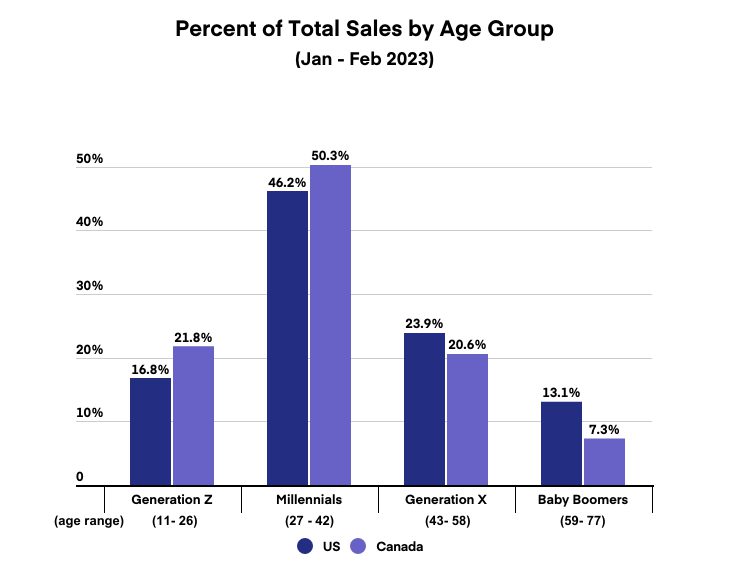
SMBs are the engine of the cannabis M&A economy
The contractions of the cannabis industry created a realignment in the sector following the industry’s early explosive success.
Laura A. Bianchi, founding partner of Bianchi & Brandt, explains the situation in a recent Trend Report stating, “We’ve been entrenched in the hyperactive cannabis M&A environment for many years, and after the massive, unexpected pandemic bump—and the ensuing crash of cannabis markets coast to coast—we’re now in The Great Correction. ”
Instead of blockbuster acquisitions and rapid multi-state expansion, we’re seeing small and midsize businesses (SMBs) are now the focus of most M&A activity.
Laura continues in the trend report, explaining “Savvy businesses are looking for mutually beneficial partnerships that allow them to maintain a foothold in the market to ride out this correction. Many of these smaller cannabis businesses are merging for basic survival. Some are finding that their new partnerships are helping them thrive in these conditions. Others are entering into bad partnerships out of desperation, and we will likely see them in court in the future.”
Cannabis mergers and acquisitions sluggish in 2024, poised for rapid growth in 2025
While 2024 wasn’t the strongest year for cannabis M&A activity, 2025 is predicted to look much different as rescheduling hearings happen and are expected to make traction.
2025 is predicted to bring another wave of mergers and acquisitions in 2025. Experts predict that larger operators with access to capital will find room to expand their portfolio through distressed assets, positioning large and small operators with opportunities to thrive.
Cannabis employment demand
The cannabis industry supports 440,445 jobs
The 2024 Vangst Jobs Report found There are 440,445 full-time equivalent jobs supported by legal cannabis as of early 2024. That number represents a 5.4% year-over-year increase, adding 22,952 new jobs over the past twelve months.
This growth was driven largely by steep-curve expansion in young Midwestern markets — Michigan, Missouri, and Illinois — and the moderate growth of East Coast markets like New York, New Jersey, and Connecticut.
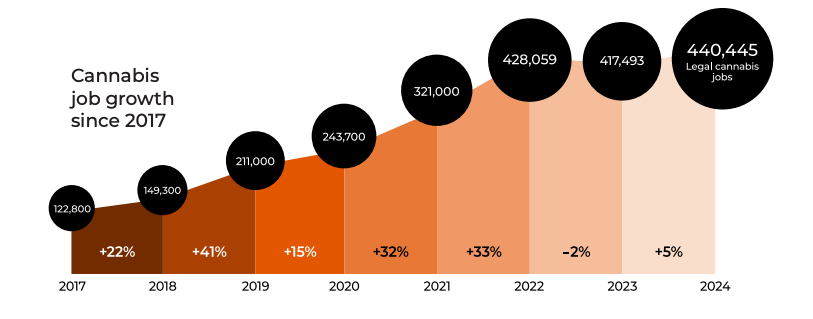
Key states have considerable job growth potential
Markets like California, New York, New Jersey, Virginia, and more are yet to tap into the full potential of their respective cannabis industries. For example, California has only reached around 83,000 cannabis jobs of a potential 133,000.
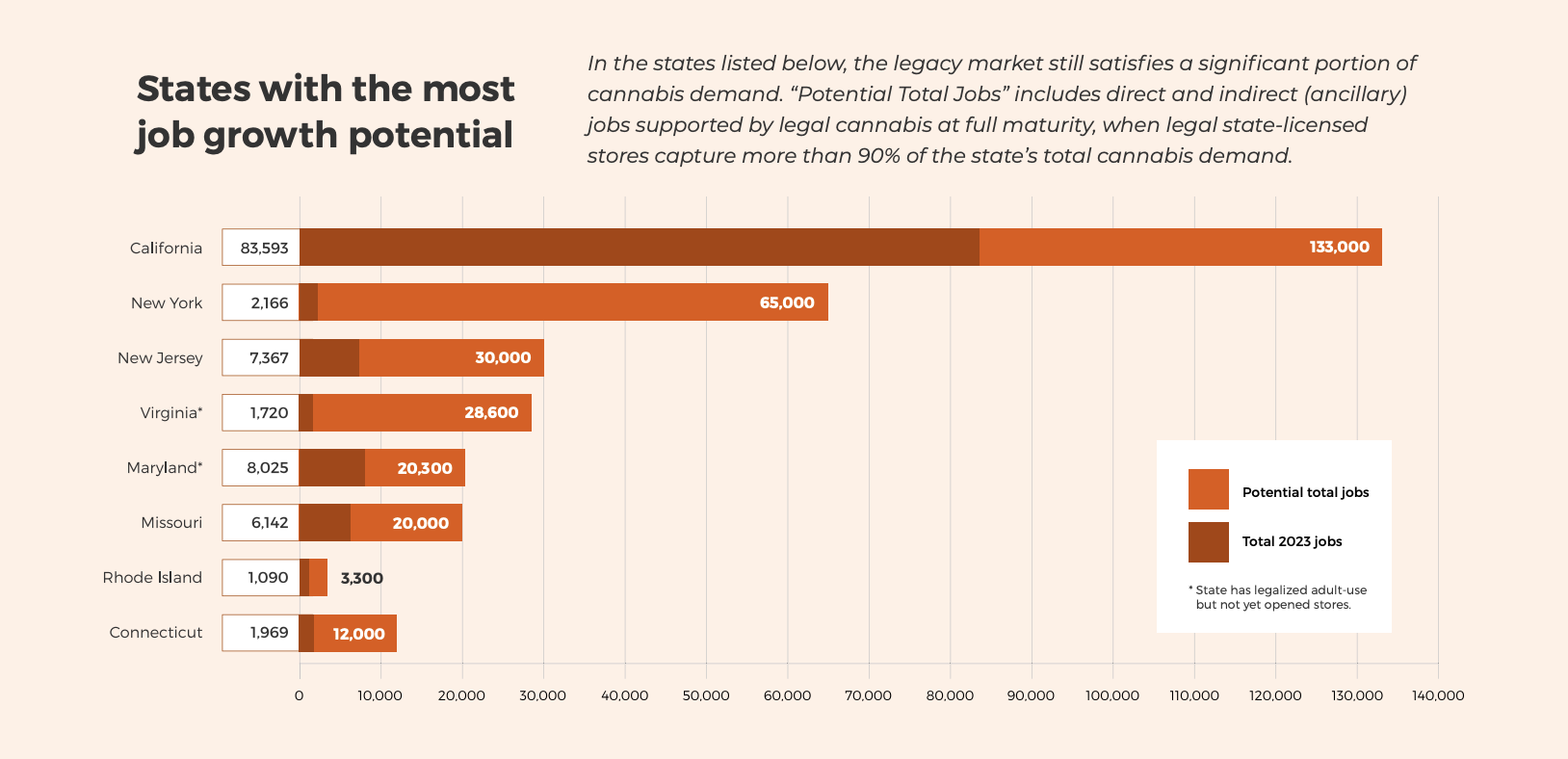
In their Jobs Report, Vangst explains, "If state policymakers work together to move legacy market consumers into legal, licensed, tax-paying stores, we should see the return of double-digit job growth."
Cannabis legal updates
Nebraska legalizes medical cannabis in 2024 election
Five states voted on cannabis legalization in the 2024 election: Arkansas, Florida, Nebraska, North Dakota, and South Dakota.
Out of all five states, Nebraska was the only state to legalize cannabis, where 70% of voters voted yes to a pair of initiatives legalizing and commercializing medical cannabis in the state.
In Arkansas, votes were not counted after the Supreme Court ruled the initiative didn’t fully explain what it would do and tossed it out.
Florida’s Amendment 3 to legalize cannabis for adult use failed, with 55.9% voting no.
North Dakota’s Measure 5 to legalize up to one ounce of cannabis for adult use failed when 47.5% of voters said no.
South Dakota’s Measure 29 legalizing adult use failed 43.9%, making this the third time a recreational cannabis measure has failed in the state.
Cannabis rescheduling hearings set for 2025 in the U.S.
Here’s a timeline of notable moments that may impact cannabis this year:
October 6, 2022 — President Joe Biden issues a statement saying, “No one should be in jail just for using or possessing marijuana.” He goes on to say he will pardon all prior offenses of simple possession of marijuana and the federal level and urge all state govs. to follow suit. The President also mentions he will be reviewing cannabis’ Schedule I designation.
Aug. 29, 2023 — A letter from the Department of Health and Human Services to Anne Milgram, of the Drug Enforcement Administration (DEA) leaks to Bloomberg. The letter calls for rescheduling cannabis as a Schedule III drug under the Controlled Substances Act.
Sep. 13, 2023 — A report by the Congressional Research Service (CRS) finds the DEA will “likely” reschedule marijuana as it would be improbable for them to contradict the HHS recommendation.
Dec. 22, 2023 — President Biden issues a proclamation that further pardons people who have certain cannabis-related convictions under federal law and also grants clemency to 11 individuals who the President said are serving disproportionately long sentences for nonviolent drug offenses.
Jan. 4, 2024 — The DEA confirms it is reviewing the cannabis rescheduling recommendation.
Jan. 12, 2024 — The U.S. government releases documents related to its ongoing review of marijuana's status under federal law. These documents provide the first official confirmation that health officials recommended the DEA reschedule cannabis, officially confirming for the first time that health officials have recommended the Drug Enforcement Administration (DEA) place cannabis in Schedule III of the Controlled Substances Act (CSA).
May 21, 2024 — The U.S. Department of Justice published a notice of proposed rulemaking to reschedule cannabis from a Schedule I to a Schedule III substance. Stakeholders and industry professionals were invited to comment publicly on July 22nd, 2024.
July 22nd, 2024 — Public comments on the notice of proposed rulemaking officially close.
August 27th, 2024 — The DEA announced the scheduling of an ALJ hearing beginning December 2nd to discuss the rescheduling of cannabis after.
December 2nd, 2024 — Formal hearing begins, and set schedule for remaining dates is decided after approximately 43,000 comments were submitted.
January 21st, 2025 — Remaining hearings on cannabis commenced and continue Tuesdays and Thursdays each week until March 6th.
For now, we can only wait and see what the DEA decides. However, one thing is for certain: cannabis policy reform will gain serious momentum in 2025.
Germany legalizes cannabis for adults - but no dispensaries yet
Germany legalized cannabis possession for adults on April 1st, 2024. Germans over 18 can legally cultivate up to 3 personal plants for private consumption.
Non-profit social clubs in Germany were made legal a few months later, where adults can come together to grow and consume limited amounts of cannabis. Licensed cannabis sales remain illegal in Germany.
Ukraine legalizes cannabis for medicinal use
Ukrainian President Volodymyr Zelenskiy signed a bill into law legalizing cannabis for medicinal use in February 2024, with the law taking effect August 16th, 2024.
It is no coincidence that Ukraine’s move came shortly after the war with Russia started heating up again. Nearly ten million Ukrainians either live with or are at risk of developing a mental health condition.
Cannabis legalization is a tool that can be used to support mental health.
Poland takes a step towards cannabis decriminalization
A Polish legislative committee sent a reform proposal to Prime Minister Donald Tusk for consideration in November 2024.
Should the initiative come to pass, adult Polish citizens would be able to possess up to 15 grams of cannabis and cultivate up to one plant for personal use.
Voters approve home cultivation in Slovenia
Slovenia decriminalized cannabis for medical purposes in 2013. However, the European nation made significant progress in June 2024 when voters overwhelmingly approved a pair of ballots that allow Slovenian adults to grow cannabis plants at home.
We hope that you've found this collection of cannabis industry statistics to be informative and useful. If you have any other research or statistics that you think would be valuable to include in this resource, please let us know by emailing us at marketingteam@flowhub.com. Your feedback and suggestions will help us continue to improve and expand this resource for the benefit of the cannabis industry. Thank you for your support!